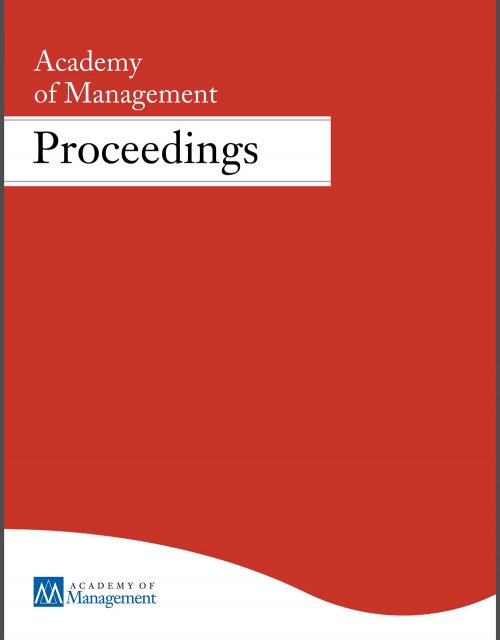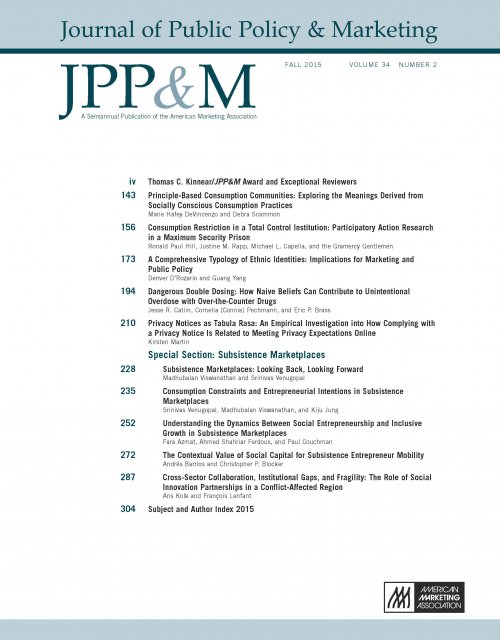Publication records
Subject(s)
Economics, politics and business environment
Keyword(s)
Vertical restraints, selective distribution, price comparison websites, effect-based approach
Subject(s)
Product and operations management
Keyword(s)
Supply chain management, uncertain consumer taste, product introduction, product positioning, store brands, national brands, information acquisition, information sharing, vertical differentiation, horizontal differentiation
In this paper, we study how a retailer can benefit from acquiring consumer taste information in the presence of competition between the retailers store brand (SB) and a manufacturers national brand (NB). In our model, there is ex-ante uncertainty about consumer preferences for distinct product features, and the retailer has an advantage in resolving this uncertainty because of his close proximity to consumers. Our focus is on the impact of the retailers information acquisition and disclosure strategy on the positioning of the brands. Our analysis reveals that acquiring taste information allows the retailer to make better SB positioning decisions. Information disclosure, however, enables the manufacturer to make better NB positioning decisions – which in return may benefit or hurt the retailer. For instance, if a particular product feature is quite popular, then it is beneficial for the retailer to incorporate that feature into the SB, and inform the manufacturer so that the NB also includes this feature. Information sharing, in these circumstances, benefits both the retailer and the manufacturer, even though it increases the intensity of competition between the brands. But, there are situations in which the retailer refrains from information sharing so that a potentially poor positioning decision by the NB makes the SB the only provider of the popular feature. The retailer always benefits from acquiring information. However, it is beneficial to the manufacturer only if the retailer does not introduce an SB due to the associated high fixed cost.
View all ESMT Working Papers in the ESMT Working Paper Series here. ESMT Working Papers are also available via SSRN, RePEc, EconStor, and the German National Library (DNB).
Pages
33
ISSN (Print)
1866–3494
Subject(s)
Marketing
Keyword(s)
Service delivery, customer–employee interaction, dysfunctional customer behavior, co-production, enforcement
JEL Code(s)
M310
Service employees frequently must enforce rules upon their customers to mitigate dysfunctional customer behavior and ensure proper service delivery (e.g., enforce “fasten seatbelt” signs on flights). However, the consequences of enforcing service rules (ESR) are not well understood. To elucidate the effect of ESR, the authors present seven studies involving > 6800 customers and consisting of cross-sectional and longitudinal data from customer surveys and company records as well as experiments. The results indicate that ESR exerts ambivalent effects: customers who experience ESR directed at other customers perceive service employees as more competent, which increases customer loyalty. However, if ESR is directed at customers themselves, they perceive a self-concept threat, leading them to devalue service employees' warmth and competence and to become less loyal. The effects of ESR hinge on a number of factors, including the harm that dysfunctional behavior potentially causes, the way ESR is communicated, and customers' experience with the service situation. Furthermore, the authors show that service employees can alleviate the negative effects of ESR by communicating service rules in advance and justifying ESR appropriately.
With permission of Elsevier
Volume
34
Journal Pages
919–941
Subject(s)
Technology, R&D management
Keyword(s)
Vulnerability, vulnerability equities processes
The report shows that a reporting of vulnerabilities used by the state for active measures is likely to have only a minor effect on the increase in overall technical IT security. On the other hand, the value of the work of the security authorities is in many cases considered high, due to the high tactical enablement against potential malicious actors. The demand of some, that state authorities should refrain from pro-actively exploiting vulnerabilities for active measures therefore does not seem to make much sense; the net effect in security would be negative. Nevertheless, processes can be introduced that allow a more precise assessment and an informed, accountable and cautious handling of offensively used vulnerabilities.
Volume
2017
Subject(s)
Strategy and general management
Keyword(s)
Decision making, judgement, crisis management, global health, organizational behavior, disaster relief, international humanitarian non-governmental organization (NGO), intergovernmental organization
The case depicts the first few weeks of the 2014 Ebola outbreak in West Africa and describes how two organizations, the World Health Organization and Doctors Without Borders, assessed the seriousness of the outbreak. Both organizations have expertise and experience in containing epidemics, and past Ebola outbreaks in particular. These organizations nonetheless reached radically opposite conclusions. The case explores the possible reasons for these differences in predicting the outbreak’s evolution.
| buy now | buy now | buy now |
Subject(s)
Health and environment; Information technology and systems; Technology, R&D management
Keyword(s)
IT security, cybersecurity, e-health, IoT, safety, medical devices
The healthcare industry is undergoing great technological transformations. Hospitals are going digital and medical devices – whether implanted in patients’ bodies or stationed in hospitals – are equipped with increasing computing power and wireless connectivity. Connected healthcare can offer safer, more efficient, and timely medical service delivery. It also presents great economic opportunities – according to a Roland Berger consultancy firm study, the digital healthcare market is set to grow at average annual growth rates of 21 percent until 2020. Yet, the integration of computing and communication technologies in safety-critical medical systems will expose them to the same network and information security (cyber security) threats as other information technology (IT) systems. Research and real-world incidents have shown that IT security risks in healthcare are systemic. Cyber attacks’ impact on the privacy of patient data has already been established. More recently, their potential impact on patient health and safety has been raising concerns for healthcare organizations, regulators, and medical device manufacturers alike. The management and governance of related risks requires comprehensive standardization, regulation, and best practices to encompass both IT security and safety. DSI has analyzed the convergence of safety and security risks in healthcare and the Internet of Things through a review of the relevant literature, as well as expert interviews and a workshop with representatives from health organizations, medical device manufacturers, IT security experts, safety engineers, regulators, and certification bodies. On this basis, DSI has developed recommendations for policy and industry, which are presented by this paper after a short analysis of the current status of security in connected healthcare.
Volume
2017
Subject(s)
Human resources management/organizational behavior; Technology, R&D management
Keyword(s)
Innovation, science, teams, collaboration, scientific credit, science policy
JEL Code(s)
O32, J01
Most scientific research is performed by teams, and for a long time, observers have inferred individual team members’ contributions by interpreting author order on published articles. In response to increasing concerns about this approach, journals are adopting policies that require the disclosure of individual authors’ contributions. However, it is not clear whether and how these disclosures improve upon the conventional approach. Moreover, there is little evidence on how contribution statements are written and how they are used by readers. We begin to address these questions in two studies. Guided by a conceptual model, Study 1 examines the relationship between author order and contribution statements on more than 12,000 articles to understand what information is provided by each. This analysis quantifies the risk of error when inferring contributions from author order and shows how this risk increases with team size and for certain types of authors. At the same time, the analysis suggests that some components of the value of contributions are reflected in author order but not in currently used contribution statements. Complementing the bibliometric analysis, Study 2 analyzes survey data from more than 6000 corresponding authors to examine how contribution statements are written and used. This analysis highlights important differences between fields and between senior versus junior scientists, as well as strongly diverging views about the benefits and limitations of contribution statements. On the basis of both studies, we highlight important avenues for future research and consider implications for a broad range of stakeholders.
Volume
3
ISSN (Online)
2375-2548
Subject(s)
Human resources management/organizational behavior
Keyword(s)
Error management, executive management
Our current environment has been typified as Volatile, Uncertain, Complex and Ambiguous or VUCA (e.g., Bennett & Lemoine, 2014; Horney, Pasmore, & O'Shea, 2010) – even before largely unpredicted developments in the political arena such as Brexit and the US presidential election. It may be argued that organizations themselves become VUCA, witness the accelerating pace at which firms rise and fall (Govindarajan & Srivastava, 2016). In that context, more and more decisions may be analyzed as errors in the making, as errors refer to “unintended and potentially avoidable deviations from organizationally specified goals and standards&x201D; (Lei, Naveh, & Novikov, 2016: 2). Insofar as errors may challenge critical organizational goals and resources, strategic error management becomes a critical challenge for leaders including top executives. Errors are pervasive at all levels of organizations (Hunter, Tate, Dzieweczynski, & Bedell-Avers, 2011; Makary & Daniel, 2016; Panko, 2008), and as we are shifting from managing stable operations to managing innovation and change, errors come in increasing numbers and kinds, with opportunities to learn from them. Errors can no longer be avoided by enforcing stability on organizations; instead, they must be managed as part of the innovation, growth, learning, and change process. This thought- provoking symposium brings together international scholars who share the idea that research on organizational errors and error management may provide insights and inform leaders at the strategic level. Our panelists will offer conclusions from recent research that will interest both scholars and practitioners in this under-explored area, and spark a debate on how to better detect, report and ultimately manage errors, for the benefit of not only organizations themselves, but also hopefully the society at large."
With permission of the Academy of Management
Volume
2017
ISSN (Online)
2151-6561
ISSN (Print)
0065-0668
Subject(s)
Ethics and social responsibility
Keyword(s)
Sustainability disclosure, sustainability report, stock market reaction, information environment, value relevance
Public policy makers seek to enhance disclosure of firms’ sustainability performance, yet firms debate about whether, or to what extent, they should engage in sustainability reporting. This article seeks to advance current understanding about the business returns to sustainability reporting by examining the short- and long-term investor reactions. Through an event study, this research documents significant short-term stock market reaction to the release of sustainability reports. In particular, abnormal stock returns around the release of such reports are positively related to firm sustainability performance, and this positive link is smaller for firms in a strong information environment. The results show that over the long term, relative to nonreporting firms, firms that release sustainability reports enjoy higher value relevance of sustainability performance. These findings suggest that sustainability reports enhance information transparency and allow investors to incorporate sustainability information in stock valuation. This study provides strong evidence for the business case of sustainability reporting, and offers important implications for public policy makers in terms of devising policies and regulations to promote sustainability reporting.
With the permission of the American Marketing Association
Volume
36
Journal Pages
313–330
ISSN (Print)
0743–9156
Subject(s)
Ethics and social responsibility; Marketing
Keyword(s)
Purpose, sustainability, strategy
Pages
99

